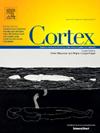The role of disconnection mechanisms in category-specific semantic disorders for living beings. A critical review
IF 3.3
2区 心理学
Q1 BEHAVIORAL SCIENCES
引用次数: 0
Abstract
This review reconsiders some debates raised by the discovery that herpes simplex encephalitis (HSE) can provoke category-specific semantic disorders (CSSD) for living entities, due to the greater weight that visual features have in the identification of members of this category. The main issues taken into account regard the interaction between two research domains. The first concerns the fractionation of the ‘living beings’ into the ‘animals’ and the ‘plant life’ categories, which has shown that the impairment of fruits and vegetables is provoked by lesions in the territory of the left posterior cerebral artery (PCA). The second concerns the role played by the etiology of lesions on CSSD for living beings. This issue stems from the fact that CSSD for living beings have been rarely reported in Semantic Dementia (SD), even if both HSE and SD involve the same anterior fronto-temporal structures. Our review strongly suggests that the impairment of plant life categories in patients with left PCA infarct may be due to a posterior disconnection mechanism, decoupling the verbal representations of fruits and vegetables from the processing of colors only through the right hemisphere. A disconnection of white matter tracts could also explain the discrepancy between HSE and SD lesions in the generation of CSSD for living beings, because SD affects only the cortical neurons, whereas the swelling lesions typical of HSE involve also the underlying white matter that plays a critical role in disconnection mechanisms.
断连机制在生物类别特异性语义障碍中的作用。批评性评论
这篇综述重新考虑了单纯疱疹脑炎(HSE)可以引起生物实体类别特异性语义障碍(CSSD)的发现所引起的一些争论,因为视觉特征在识别这一类别的成员中占有更大的权重。考虑到的主要问题是两个研究领域之间的相互作用。第一个是将“生物”分为“动物”和“植物”两类,这表明水果和蔬菜的损伤是由左脑后动脉(PCA)区域的病变引起的。第二个是关于生物的CSSD病变的病因所起的作用。这个问题源于这样一个事实,即即使HSE和SD涉及相同的前额颞叶结构,生物的CSSD在语义性痴呆(SD)中很少被报道。我们的研究强烈表明,左侧PCA梗死患者的植物生命类别损伤可能是由于后路断开机制,将水果和蔬菜的口头表征与仅通过右半球处理的颜色分离。白质束的断开也可以解释生物CSSD产生中HSE和SD病变的差异,因为SD仅影响皮质神经元,而典型的HSE肿胀病变也涉及在断开机制中起关键作用的底层白质。
本文章由计算机程序翻译,如有差异,请以英文原文为准。
求助全文
约1分钟内获得全文
求助全文
来源期刊

Cortex
医学-行为科学
CiteScore
7.00
自引率
5.60%
发文量
250
审稿时长
74 days
期刊介绍:
CORTEX is an international journal devoted to the study of cognition and of the relationship between the nervous system and mental processes, particularly as these are reflected in the behaviour of patients with acquired brain lesions, normal volunteers, children with typical and atypical development, and in the activation of brain regions and systems as recorded by functional neuroimaging techniques. It was founded in 1964 by Ennio De Renzi.
 求助内容:
求助内容: 应助结果提醒方式:
应助结果提醒方式:


